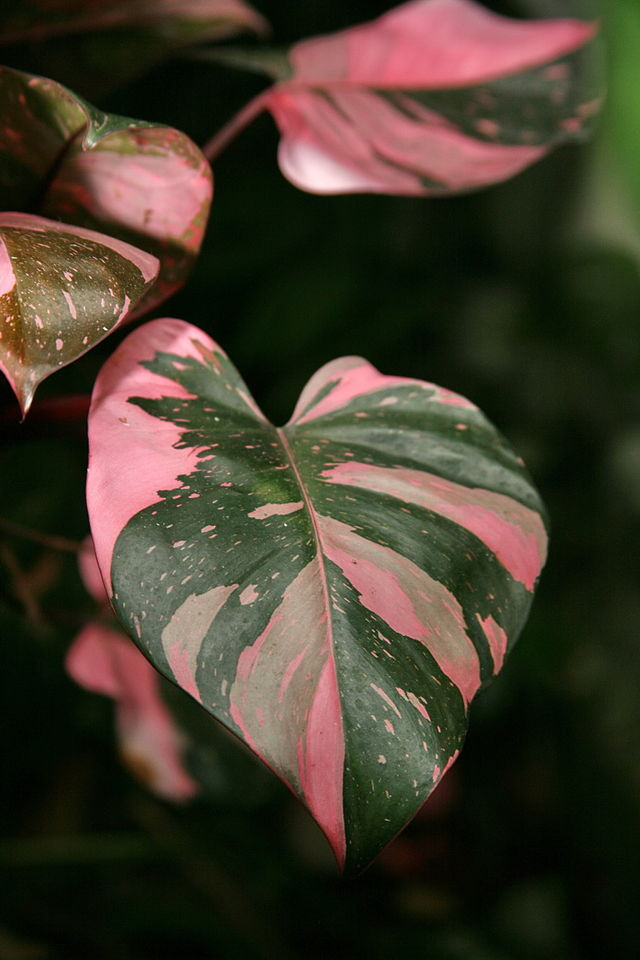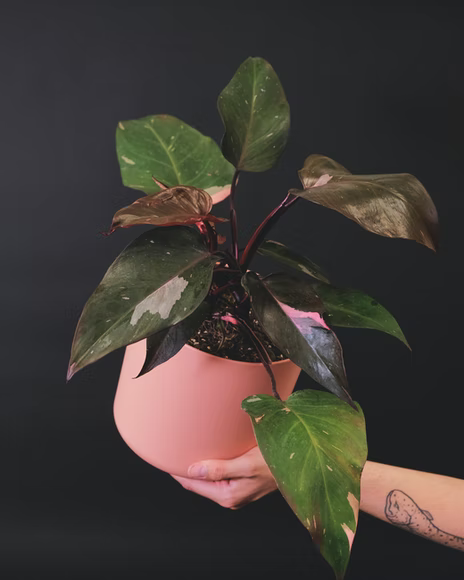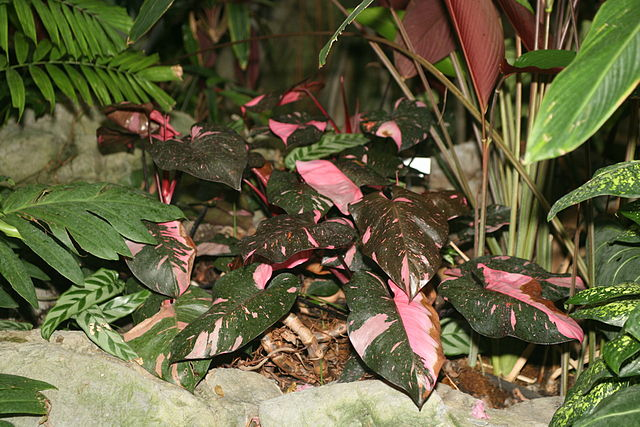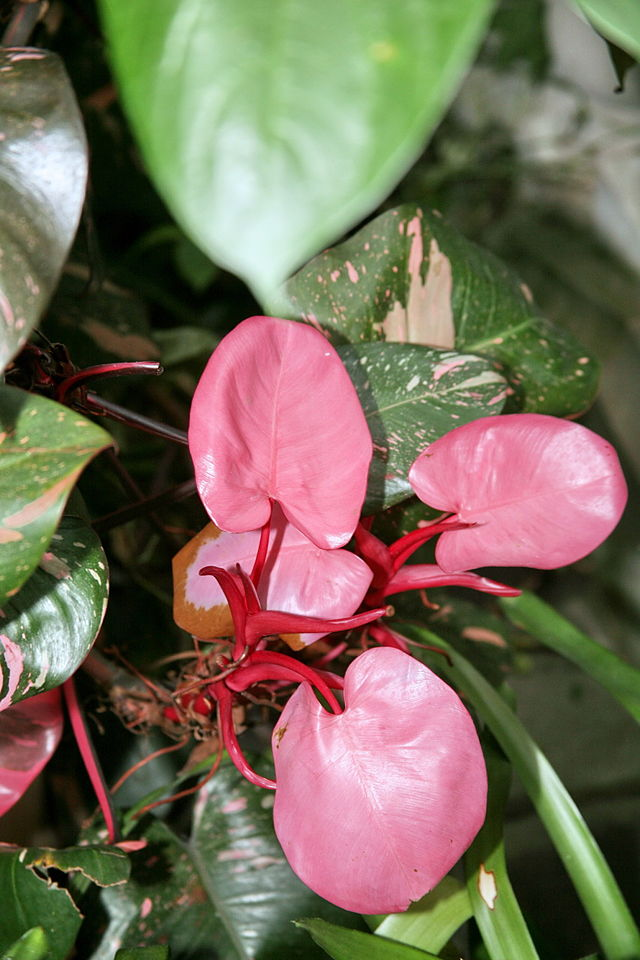Who wouldn’t be captivated by this gorgeous and highly sought-after royalty? The Philodendron Pink Princess is undoubtedly on top of many plant collectors and enthusiasts’ regards. Despite its being royalty, it is a low-maintenance plant with a standout pink variegation with a touch of copper and red on its underside.
If you wish to have this plant in your hands, keep reading and learn more about proper care and ensure that it maintains its regal beauty.

Philodendron Pink Princess Profile
General Information
Philodendron erubescens or Pink Princess is a perennial plant of the family Araceae. Its mature form can reach up to 2-4 feet tall and 2-4 feet wide. It is a native of South America, particularly in Colombia.
This plant stands out due to its unique waxy, dark green, and bubblegum pink variegation. Although it can be easily confused with Philodendron pink congo, its coloration is more stable as it occurs naturally, whereas Pink Congo Philodendron results from chemical manipulation.
Fun fact: its natural pinkness on the leaves is due to the lack of chlorophyll- a compound that makes plants’ leaves green, which helps them create oxygen and glucose. The Pink Princess goes perfectly well in pots or hanging baskets where their pink leaves easily create a showpiece.
Etymology
The botanical name “philodendron” comes from the Greek words “philo”, meaning “love” and “affection”, and “dendron,” meaning tree. So the Philodendron is loosely translated as “tree huggers” with these meanings. This is because they are often seen in the wild as tree climbers.
Philodendron Pink Princess earned its name through its superb coloration. In some areas, it is also called blushing philodendron or pink philodendron.
Flowering
While this gem produces flowers, its spathes are pretty insignificant compared to the beauty of its foliage. It usually blooms during the spring and summer time as it loves warmth, provided that its other requirements are also met.
Season Of Interest And Purchasing
It is best to purchase this aroid during the spring and the summer as it actively grows during that time.
Growth
The plant needs a bright spot with indirect light and moist, well-draining water to thrive. As mentioned above, it can grow up to 2-4 feet in height and width. Its stems may also grow in a bushy way when it is regularly pruned. A moss pole can be used for this vining plant.
Philodendron Pink Princess Overview
| Scientific name | Philodendron erubescens ‘Pink Princess’ |
| Common name/s | Pink Princess Philodendron |
| Family | Araceae |
| Growth Habit | Herbaceous |
| Height and Spread | Depends on the space. Can grow up to 3-4 feet in height, and 1-2 feet in spread. |
| Classification based on life cycle | Perennial |
| Origin and Distribution | Originates from Colombia |
| Climate Zone | Generally warmer climate |
| USDA Plant Hardiness Zone | USDA Zone 10 – 12 |
| Color | Glossy evergreen leaves with bubblegum pink variegated plants |
RELATED: Philodendron Birkin: Its Most Informative Care, Propagation, and Watering Guide
Care Tips

Light Requirement
Philodendron Pink Princess grows best in bright, indirect light. This kind of light provides the optimal lighting conditions for it to be healthy and have a balanced leaf coloration. An alternative may also be used, such as filtered lights through curtains or diffusers. However, it is not recommended to have too much direct sunlight on its leaves for more than four hours, so it might be best to place it in an east- or west-facing room.
If you’re in a very sunny location and there is direct light, your plant may need some shade. It is recommended that it is placed in a south-facing room, away from the window. An indication of whether your plant is getting too much sunlight is having yellow leaves. If this starts to happen, make sure to move your plant to a more shaded location.
Too little light, on the other hand, slows the growth of your Pink Princess plants and does not encourage balanced variegation. An artificial grow light can be used indoors to continue having brilliant pink variegation.
Temperature Requirement
The healthy temperature for the Pink Princess is around 55 to 95 degrees Fahrenheit. Meanwhile, it is happiest when optimum temperatures are between 75 to 84 degrees Fahrenheit. Therefore, make sure that your plant does not get too cold during the evening, specifically below 59 degrees Fahrenheit.
Water Requirement
The general rule for Philodendron species is to only water it when the top 1-2 inch has dried out. To know this, you can press the soil, and if there is no moisture, you need to water the plant. Make sure you do thorough watering and that the water reaches the bottom of the pot until it drains out. Signs that your plant is not getting enough water include being wilted and dry.
On the other hand, keep in mind that this can have root rot, fungi, bugs, and other issues resulting from overwatering, just like any other plant. So instead of having a fixed watering schedule, water them whenever the soil dries out.
Humidity Requirement
Just like any tropical houseplants, the Pink Princess needs plenty of humidity. Usually, the household humidity is still too dry for these plants, so you might have to do more to get the humidity levels right.
One way to keep your plant happy is by misting its leaves. You can spray fine mist above your plant’s leaves every 2-3 days on regular days, while you may need to do it daily during hot days. You can use a regular spray bottle.
Other ways to provide sufficient humidity are using room humidifiers (particularly around 40% humidity), pebble tray humidifiers, or simply grouping the house plants. This proximity among the plants can create a natural humid atmosphere, similar to their native environment.
Soil Requirement
The Pink Princess enjoys airy, well-draining soil high in organic matter. To keep the soil conditions ideal, you can use a standard potting soil mixture, one part perlite, and one part orchid bark. This potting soil mix will ensure your plant good drainage and aeration for healthy roots and overall good plant’s health.
Fertilizer Requirement
The best type of fertilizer for the Pink Princesses is a balanced one, preferably a balanced liquid fertilizer with complete micro and macronutrients. You can feed your plant every four weeks during spring and summer, as this is the time that they actively grow. There’s no need to fertilize during fall and winter as this is when their growth slows down.
It may also be helpful to flush the soil every once in a while, specifically about every four to five months, to avoid salt buildup. To do this, run water slowly through the potting mix for two to three minutes. You can resume with regular watering and feeding when the top 1 inch of soil has already dried.
Space Requirement
A mature Philodendron Pink Princess only grows about 2-4 high and wide, so it does not need much space to grow. However, it may be helpful to report it when the roots have already outgrown their pot or transfer it to a more spacious area when their leaves have already grown.
RELATED: Philodendron Florida Ghost: The Ultimate Care, Propagation, and Watering Guide
Growing And Planting Tips
Propagation
The Pink Princess propagation is extremely easy relative to other plants. The best way to propagate it is through stem cuttings. Here are the following steps you can follow in propagating Pink Princess Philodendron:
- Cut a stem below one of the nodes of the plant. Make sure that you pick a healthy stem with 3 to 4 pinkish leaves.
- Place the selected cutting in a jar of water.
- Wait a few weeks until roots appear.
- When the roots are about 2 inches long, you can plant the cutting in a pot filled with a light potting mix.
In addition to stem cuttings, root division is another way to propagate the Pink Princess. You can divide the plant with at least four stems at the root when repotting. You can then carefully separate the roots until you have at least two or three stems in each new plants. Continue as instructed above.
It is best to propagate Pink Princess plants during their active growing season, spring and summer.
Pruning
The Philodendron Pink Princess benefits from regular pruning. The best time to do this is during spring or fall or after spring and summer. Yellow or dying leaves should also be pruned to keep the plant’s bright pink spots vigorous and healthy. Pruning also encourage variegation and new growth.
Potting And Repotting
It is recommended that the Philodendron Pink Princess is reported once a year when they are young. After reaching maturity, they should be repotted every two years. Doing so gives you the chance to refresh your potting mix and encourage plant growth. It also prevents your plant from becoming rootbound, further helping with the drainage.
Philodendron Pink Princess Care
| Light | Medium to indirect bright light |
| Temperature | Intermediate to warm, 55-95 degrees Fahrenheit |
| Water | Once a week, increased in summer, decreased in winter |
| Soil | Airy, well-draining soil |
| Fertilization | Regular household fertilizer, once a month |
| Space | Minimal space |
| Propagation | Via stem propagation |
| Blooming | Rarely blooms, enough sunlight and maturity needed |
| Pruning | Regular pruning |
| Potting | Regular potting mix, use of perlite and orchid bark is recommended |
RELATED: Philodendron gigas: The Care, Propagation, and Watering Guide You Need
Problems And Troubleshooting
Pests
Unfortunately, even some royalties are not immune to developing diseases. The most common houseplant pests for Philodendron are mealybugs or aphids. Getting rid of them may require neem oil, insecticidal soap, and diatomaceous earth. You may also have to change the soil as pests commonly live there.
Diseases
On the other hand, most diseases that affect Philodendron plant are root rot caused by overwatering. One way to know that your plant is being overwatered is wilting leaves. So always make sure only to water your plants when the first 1-2 inch of the soil has completely dried out. For a more detailed watering guide, refer to the sections above.
Browning
The last thing you want to see is your beautiful pink plant turning green. Usually, the browning of the leaf edges is caused by a lack of humidity which causes them to dry out. Unfortunately, there is no way to reverse this damage. The thing you can do, though, is to increase the humidity to prevent further browning of the leaves.
You may also see brown spots on your plant’s variegation. These are called burn spots, and it usually means that you have exposed your plant to too harsh light. It may also result from too little humidity, so make sure that your plant is getting the requirements it needs!
Pink Princess Pests And Diseases
| Common Pests/Diseases | Symptoms | Treatment and Prevention |
Common diseases include crown rot, stem rot, root rot, leaf spot, fungal diseases, and Xanthomonas infection | Yellowish rimming around black or dark brown spots on leaves | Avoid overwatering. Keep soil dry. Avoid too high humidity.Proper ventilation is needed around the plant. Remove infected parts of fungal infections to avoid spreading. |
| Common pests include mealybugs, spider mites, aphids, and scales | Visible insects on the surface | Spray plant with warm, soapy water. If infestation is present, use insecticide or neem oil. Use diatomaceous earth. |
Problems With People And Animals
Toxicity
Unfortunately, this plant is toxic to your pets in your home. Its variegation is toxic to cats and dogs due to the sap that contains calcium oxalate crystals. These crystals can cause severe irritation to the skin or when accidentally ingested.
Philodendron Plants Meaning And Symbolism
Philodendrons symbolize a love of nature, perfect for plant lovers and those who have a strong passion for eco-friendly living. They also symbolize personal growth, so they would make an ideal gift for someone going through significant life events or making personal improvements.
Philodendron Pink Princess Symbolism And Meaning
| General Meaning | love of nature, passion for eco-friendly living |
| Symbolism | Personal growth |
Landscaping And Gardening Ideas

Companion Plants
Other tropical plants go well with Philodendrons. Some of the plants you may consider include bird of paradise, areca palms, fire spike, heliconia, variegated arboricola, croton, chenille plant, and pentas. Some of these plants will have additional colors and hues of warm oranges and reds, perfectly complementing your excellent dark greens.
Landscaping Ideas
Medium-sized Philodendrons go well as accents inside a humid room or a cozy deck or patio. A full plant can also be placed in the corner of the house or along the entryway. Outdoors, it can be a filler plant for a garden corner, in between palm trunks, or under tall trees. It can also be placed near pools to add even more tropical vibes as long as it won’t get splashed at.
| What to plant with | Bird of Paradise, Areca Palms, Fire Spike, Heliconia, Variegated Arboricola, Croton, Chenille Plant, Pentas |
| What NOT to plant with | Basically nothing |
Conclusion

The Pink Princess is undoubtedly a superb and unique Philodendron. With its stunning variegation, easy propagation, and relatively low maintenance care, there is no wonder why many people fight for this beauty during garden fairs.
FAQs
Is The Pink Princess Philodendron Rare?
Pink Princess was once a rare plant. However, due to extensive cultivation and the presence of tissue culture propagation, it is now easy to get a hand on this beautiful plant.
How Do You keep Pink Princess Philodendron Pink?
The bubblegum pink variegation of Pink Princess is significantly induced by proper lighting. To have beautiful variegation, make sure you put the plant in an environment with appropriate and enough sunlight.
Is Pink Princess Philodendron Easy To Care For?
Pink Princess is a low-maintenance plant. New plant collectors can have this plant in their own spaces because they are very easy to care for. No advanced expertise is needed.
Why Is The Philodendron Pink Princess Expensive?
Pink Princess Philodendron is expensive because it is very difficult to have perfect pink variegations on the plant. Unless proper care and nourishment are ensured, there is no guarantee that your plant will have pink mutations.
Why Is My Pink Princess Not Turning Pink?
Hot pink variegation on your Pink Princess Philodendron are mainly induced by sunlight and good genes. So if your Pink Princess has not given you pink variegations, it could be that the plant has not received enough light. Give it more light.
Also, it may have been reverted to an ordinary Green Philodendron. To avoid this, cut the newly emerged green young leaves. Continue to do this until pink variegation is already present.
Do You Like The Philodendron Pink Princess? Discover More Beautiful Plants, Check Out Our Other Articles:
11 Frequently Asked Questions on How to Care for a Philodendron Birkin
Philodendron camposportoanum: The #1 Care, Watering, and Propagation Guide
Philodendron Erubescens: The Best Care, Propagation, and Watering Guide







